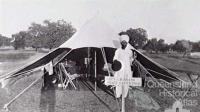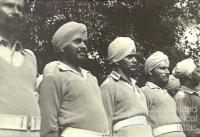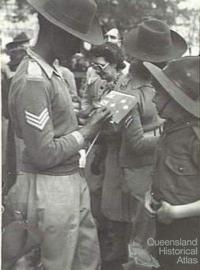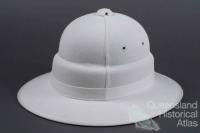- Home
- Quintessential Queensland
- Distinctiveness
- Perceptions
- Perceptions: how people understand the landscape
- From runs to closer settlement
- Geological survey of Queensland
- Mapping a new colony, 1860-80
- Mapping the Torres Strait: from TI to Magani Malu and Zenadh Kes
- Order in Paradise: a colonial gold field
- Queensland atlas, 1865
- Queensland mapping since 1900
- Queensland: the slogan state
- Rainforests of North Queensland
- Walkabout
- Queenslanders
- Queenslanders: people in the landscape
- Aboriginal heroes: episodes in the colonial landscape
- Australian South Sea Islanders
- Cane fields and solidarity in the multiethnic north
- Chinatowns
- Colonial immigration to Queensland
- Greek Cafés in the landscape of Queensland
- Hispanics and human rights in Queensland’s public spaces
- Italians in north Queensland
- Lebanese in rural Queensland
- Queensland clothing
- Queensland for ‘the best kind of population, primary producers’
- Too remote, too primitive and too expensive: Scandinavian settlers in colonial Queensland
- Distance
- Movement
- Movement: how people move through the landscape
- Air travel in Queensland
- Bicycling through Brisbane, 1896
- Cobb & Co
- Journey to Hayman Island, 1938
- Law and story-strings
- Mobile kids: children’s explorations of Cherbourg
- Movable heritage of North Queensland
- Passages to India: military linkages with Queensland
- The Queen in Queensland, 1954
- Transient Chinese in colonial Queensland
- Travelling times by rail
- Pathways
- Pathways: how things move through the landscape and where they are made
- Aboriginal dreaming paths and trading ways
- Chinese traders in the nineteenth century
- Introducing the cane toad
- Pituri bag
- Press and the media
- Radio in Queensland
- Red Cross Society and World War I in Queensland
- The telephone in Queensland
- Where did the trams go?
- ‘A little bit of love for me and a murder for my old man’: the Queensland Bush Book Club
- Movement
- Division
- Separation
- Separation: divisions in the landscape
- Asylums in the landscape
- Brisbane River
- Changing landscape of radicalism
- Civil government boundaries
- Convict Brisbane
- Dividing Queensland - Pauline Hanson’s One Nation Party
- High water mark: the shifting electoral landscape 2001-12
- Hospitals in the landscape
- Indigenous health
- Palm Island
- Secession movements
- Separate spheres: gender and dress codes
- Separating land, separating culture
- Stone walls do a prison make: law on the landscape
- The 1967 Referendum – the State comes together?
- Utopian communities
- Whiteness in the tropics
- Conflict
- Conflict: how people contest the landscape
- A tale of two elections – One Nation and political protest
- Battle of Brisbane – Australian masculinity under threat
- Dangerous spaces - youth politics in Brisbane, 1960s-70s
- Fortress Queensland 1942-45
- Grassy hills: colonial defence and coastal forts
- Great Shearers’ Strike of 1891
- Iwasaki project
- Johannes Bjelke-Petersen: straddling a barbed wire fence
- Mount Etna: Queensland's longest environmental conflict
- Native Police
- Skyrail Cairns (Research notes)
- Staunch but conservative – the trade union movement in Rockhampton
- The Chinese question
- Thomas Wentworth Wills and Cullin-la-ringo Station
- Separation
- Dreaming
- Imagination
- Imagination: how people have imagined Queensland
- Brisbane River and Moreton Bay: Thomas Welsby
- Changing views of the Glasshouse Mountains
- Imagining Queensland in film and television production
- Jacaranda
- Literary mapping of Brisbane in the 1990s
- Looking at Mount Coot-tha
- Mapping the Macqueen farm
- Mapping the mythic: Hugh Sawrey's ‘outback’
- People’s Republic of Woodford
- Poinsettia city: Brisbane’s flower
- The Pineapple Girl
- The writers of Tamborine Mountain
- Vance and Nettie Palmer
- Memory
- Memory: how people remember the landscape
- Anna Wickham: the memory of a moment
- Berajondo and Mill Point: remembering place and landscape
- Cemeteries in the landscape
- Landscapes of memory: Tjapukai Dance Theatre and Laura Festival
- Monuments and memory: T.J. Byrnes and T.J. Ryan
- Out where the dead towns lie
- Queensland in miniature: the Brisbane Exhibition
- Roadside ++++ memorials
- Shipwrecks as graves
- The Dame in the tropics: Nellie Melba
- Tinnenburra
- Vanished heritage
- War memorials
- Curiosity
- Curiosity: knowledge through the landscape
- A playground for science: Great Barrier Reef
- Duboisia hopwoodii: a colonial curiosity
- Great Artesian Basin: water from deeper down
- In search of Landsborough
- James Cook’s hundred days in Queensland
- Mutual curiosity – Aboriginal people and explorers
- Queensland Acclimatisation Society
- Queensland’s own sea monster: a curious tale of loss and regret
- St Lucia: degrees of landscape
- Townsville’s Mount St John Zoo
- Imagination
- Development
- Exploitation
- Transformation
- Transformation: how the landscape has changed and been modified
- Cultivation
- Empire and agribusiness: the Australian Mercantile Land and Finance Company
- Gold
- Kill, cure, or strangle: Atherton Tablelands
- National parks in Queensland
- Pastoralism 1860s–1915
- Prickly pear
- Repurchasing estates: the transformation of Durundur
- Soil
- Sugar
- Sunshine Coast
- The Brigalow
- Walter Reid Cultural Centre, Rockhampton: back again
- Survival
- Survival: how the landscape impacts on people
- Brisbane floods: 1893 to the summer of sorrow
- City of the Damned: how the media embraced the Brisbane floods
- Depression era
- Did Clem Jones save Brisbane from flood?
- Droughts and floods and rail
- Missions and reserves
- Queensland British Food Corporation
- Rockhampton’s great flood of 1918
- Station homesteads
- Tropical cyclones
- Wreck of the Quetta
- Pleasure
- Pleasure: how people enjoy the landscape
- Bushwalking in Queensland
- Cherbourg that’s my home: celebrating landscape through song
- Creating rural attractions
- Festivals
- Queer pleasure: masculinity, male homosexuality and public space
- Railway refreshment rooms
- Regional cinema
- Schoolies week: a festival of misrule
- The sporting landscape
- Visiting the Great Barrier Reef
By:
Richard Gehrmann Shipwrecks around an isolated continent in the southern hemisphere were common. As an imperial settlement, many ships carried troops as well as convicts and goods. In the early colonial era India was a major trading partner. On the 20 June 1825, the three-masted Royal Charlotte was wrecked while sailing from Sydney through Queensland waters, carrying British troops and their families via Batavia to India. Survivors waited for six weeks on Observatory Cay, a small Coral Sea sandbank near the Fredrick Reef 450 km from the Queensland coast before they were rescued by the government brig Amity and taken to the just established Moreton Bay convict settlement.
This was not the only shipwreck of India-bound troops in Queensland waters – in April 1841 the Ferguson’s passage to Madras with 170 soldiers of the 50th Regiment also ended in shipwreck on the outer edge of the Great Barrier Reef.
Colonial connections with India
The movement of soldiers to India through Queensland was a routine facet of military life in colonial times. British soldiers were stationed in Australia until 1870, and many regiments were posted from Britain to Australia and then on to India, often spending decades in the colonies. Other soldiers settled in Australia at the conclusion of their Indian service, seeking colonial opportunities from farmland to a home of their own, denied to them in Britain. They bought artefacts, ideas and experiences in a cross-fertilisation of colonial cultures.
Soldiers and their families who lived in Queensland also travelled to and from India. Four of the British Army regiments with detachments at the Moreton Bay convict settlement subsequently travelled to India in the nineteenth century. Soldiers who had commanded the convict settlement often experienced different fates. While George Gravatt died in India in 1843, Sydney Cotton achieved Lieutenant-General's rank and a knighthood in a career that took him from Britain to India in 1810, to New South Wales in 1824, a return to India in 1825, to Queensland in 1837 and finally back to India after 1842. Both these soldiers are commemorated in Brisbane suburban nomenclature: Mt Gravatt and Mt Cotton.
Queensland terrain was also traversed by those who had been soldiers in India in more humble circumstances. John Longstaff’s 1907 painting of Burke and Wills at the Dig Tree in 1861 emphasises the two leaders, but the only survivor of the expedition was John King, Irish-born, who travelled to India as a soldier in 1853 and fought in the Indian Rebellion. He was recruited to supervise the expedition’s Indian camel handlers, many of whose descendents became a feature of western Queensland life. King travelled through western Queensland from Cooper Creek to the Gulf of Carpentaria and back, and while we think of King as a participant in the history of settler exploration, he brought his experiences of living in India to Australia.
Other soldiers of India made Queensland their home, including former Bengal Cavalry officer Robert Gray, who, after fighting in the Indian Rebellion of 1857-58 visited Australia on leave, and decided to settle in the Burdekin district. The future town of Hughenden developed on his former station, and the very title of his 1913 memoir Reminiscences of India and North Queensland is a telling reminder of the linkage his colonial experiences provide.
The Raj after Federation
Links between India and Australia became formalised after Federation. Soldiers went to British India for training at the Indian Army Staff College in Quetta. Young officers were also sent to India for real-world military experience following their graduation from the Royal Military Academy at Duntroon. Others were sent on exchanges, returning with rich experiences of an exotic and different world.
Ipswich born Charles Brand, educated in Bundaberg and Maryborough, balanced his teaching career with his duties as a part-time officer in the Queensland Volunteer Infantry before joining the newly established permanent forces of the Australian Army. Sent to Secunderabad in southern India for two years in 1910, he discovered a world far removed from the classrooms of Charters Towers.
Queensland women served in India during World War I, including Rockhampton women Ethel Allchin, Marianne Dowling and Helen Lawson who worked as Australian military nurses in western India, where they cared for the sick and wounded of all races, both allied and enemy.
The relationship with India included the families of soldiers. Roma-born Jessie Vasey (later founder of the War Widows Guild of Australia) attended Moreton Bay Girls High School before moving to Victoria and marriage to future General George Vasey. Her husband was posted to the Staff College in India in the late 1920s, and in 1934 was sent to India on exchange for four years. On both occasions Jessie Vasey accompanied him, experiencing the demanding life of the British Raj officer’s wife including interaction with the many servants deemed essential for such a position. While her husband was not engaged directly in active service, life in India could be challenging at a time when European officials were the victim of terrorist attacks and where the possibility of fighting on the North-West Frontier was an ever-present reality. Each of the Vasey’s two children experienced life in colonial India, a world far removed from the experiences of their Australian peers.
World War II
During World War II, the Australian military association with India became stronger. Queenslanders were among the thousands of Australians who garrisoned Ceylon (Sri Lanka) in 1942, flew as aircrew in India and Burma, and who trained the Indian army in jungle warfare. Brisbane born and Toowoomba educated William Parry-Okeden, a station manager and stock and station agent from the Darling Downs, fought in the Middle East and New Guinea before going to India in 1943 to instruct the British and Indian army on jungle warfare techniques. While he enjoyed his work there, he disagreed strongly with many aspects of the British imperial governance of India, and was appalled by colonial arrogance, government ineptitude and disparities between rich and poor.
During World War II, the Japanese used allied prisoners of war, including Indians, as labourers. Some served in Papua New Guinea, and 6344 Indian prisoners of war were liberated by Australian forces. For many, rehabilitation at the ‘Little India’ developed at Grovely in Brisbane was the first step to recovery and repatriation to India. Together with the physical rehabilitation facilities at Grovely, the Agriculture Department set up a farm to demonstrate to the Indians how to cultivate using what were referred to in 1945 as ‘modern methods’.
The links with India were specifically colonial exchanges, and as the empire declined, so did this relationship. The military association between Australia and India ended in 1947 with Indian independence, and the bilateral relationship focused on cricket until India's economic rejuvenation in the 1990s. When we consider the shipwreck of the Royal Charlotte and the Dig Tree, these simple images recall the memory of a past history of intercolonial connections, and of the many links that existed between the subordinate elements of the British Empire.
References and Further reading (Note):
Richard Gehrmann, 'Colonial subalterns of Empire: Australians in India during the movement for Swaraj, 1920 – 1939', The British world: religion, memory, society, culture, Toowoomba, USQ, 2012. Available at http://eprints.usq.edu.au/22032/
References and Further reading (Note):
Beverley Kingston, ‘The taste of India’, Australian cultural history, 9, 1990
References and Further reading (Note):
Rodney Pratt and Jeff Hopkins, ‘The scarlet legacy: the British Army's forgotten presence in Moreton Bay, 1860-69’, Sabretache, 42/ 2, 2001
References and Further reading (Note):
David Walker and Agnieszka Sobocinska (eds), Australia's Asia: from yellow peril to Asian century, Crawley, WA, UWA Publishing, 2012
References and Further reading (Note):
Craig Wilcox, Red Coat Dreaming: how colonial Australia embraced the British army, Cambridge, Cambridge University Press, 2009
References and Further reading (Note):
‘Miniature India at Grovely’, Courier-Mail, Brisbane, 15 September 1945, p.4









